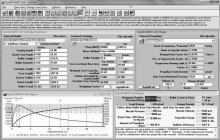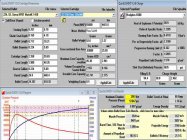Starting to load some 22-250 rounds for a buddy tonight and was surprised at what QuickLOAD returned. Using H380 powder with Sierra 52Gr. HPBT MK #1410 bullets. Started with Hodgdon web site and plugged in my powder and bullet. Hodgdon web site shows starting load at 38.0Gr. Vel=3509, Max load 41.0Gr. Vel=3717 using 52Gr. A-MAX but does not provide barrel length. Sierra manual shows 38.0Gr. Vel=3500 and Max load 39.2Gr. Vel=3600 with a 26" barrel. Since both show 38.0Gr. at 3500fps I set my QL barrel length at 26" to compare the data. I have loaded 38.6Gr. in the past with an average Vel of 3594 out of a 24" barrel
Here is the problem. If I plug in 38.0Gr into QL, I get a Vel of 3779 and 39.2Gr. a Vel of 3900fps; both of these are about 300fps higher then Hodgdon or Sierra show with the same powder charge. Now if I plug in the 41.0Gr. that Hodgdon shows as Max, I get a Vel of 4080 and WAY over maximum pressure. I would not think that Hodgdon would show a load that would be this high even with all the disclaimers. This make me think the data I am getting from QuickLOAD is incorrect. ???
I have included a screen shot of the 41.0Gr. Please let me know if you see anything I am doing incorrectly here to show this data.

Thanks!
-

QL-Data High-640X480.jpg
77.7 KB
· Views: 69
In my .22-250s, the case capacity is more than you are using. Winchester cases are 45.3 and Remington are 46.0. I bought 500 Lapua cases but have not fired any yet. Try the smaller number and see what effect it has. It should reduce your pressure. Also, both of my rifles seat the 52 MK at 2.400, touching the lands.
Thanks Steve. Changing the case capacity to 46 did bring the pressure down into the safe zone. I will measure my Remington cases capacity tonight to get that going. The QL Vel is still showing a much higher Vel than Hodgdon or Sierra show for 38.0Gr by 168 pfs. Do you see anything else?
I just went through the same confusion with a friend's 338 Lapua. There were substantial differences between QL and the published values from the powder companies. To be safe, we used the starting loads from the powder companies and then shot three shot strings in 0.5gr increments up to the QL maximums checking for pressure signs at every step. We found QL to be a better predictor of the resulting MV and maximum safe loads than anything from the powder manufacturers. I don't know how much is variation of equipment and how much is "lawyer loads" but QL has been more reliable in my experience. Sleepygator did raise what I believe is one of the keys to success with QL and that is the seating depth of the bullet. Pressure in QL is very sensitive to seating depth of the bullet which greatly effects the internal volume of a loaded round. The pressure difference can be very large if you are seating to feed through a magazine versus seating out in the neck for a single shot match rifle. I also tweek the case volume as I have found the QL estimates a bit on the high side particularly if the value is being imported from QuickDesign. But, I find the best use of QL to be as a tool to develop a reasonable ladder test for something new then evaluate the results at the range.
I've been using QL with great results for about four years, but there are (aside from the obvious seating depth, etc.) two pieces of information that are absolutely essential to input correctly to obtain the best results from the program.
#1) Water capacity of your fired cases. You'd be surprised how much even a .2 grain difference can make, especially when loading near true max. From what I can tell, QL's "default" case capacity for the various chamberings is a bit low from what you normally encounter in the real world, and this results in higher velocity/pressure predictions.
#2) The actual burn rate of your particular lot of powder. Rarely is the default setting exactly the same as what you have. Before I try any real predictive work with QL, I test my lots burn rate. Though it's kind of a pain in the butt (requires a range trip prior to really tweaking a load), it's worked well for me. I load up five rounds with a book published "start" load, and five rounds with an upper "mid-level" load and fire them over the chrono and record the data. Then I get back at the computer and tweak the burn rate within the program until I get a "line of best fit" that yields predictions that closely match both loads recorded velocities. The predictions on both the high and low end are never exact, but they can be pretty darn close. Using the newly established burn rate, your future predictions (using that particular lot of powder) are usually amazingly close to what you'll encounter in future load development.
Only one time have I encountered a lot of powder, a single pound of Varget, that actually performed exactly as predicted with the default burn rate. I once ran across a pound of H322 that exhibited a 9% higher burn rate than the default. Keep in mind the relationship between BR and pressure/velocity isn't a straight linear relationship, so it didn't result in a 9% increase in velocity.
But when all gun and powder specifics are in place, QL can be an amazingly accurate tool
Mike
Why worry about it? Who cares what any of that stuff says? The whole point isn't to make performance match a program or manual. No matter what a computer program or loading manual says, a load's accuracy/velocity in a particular gun will be whatever it is. Only way to find out is by actually testing.
This is true. No computer program can predict with any certainty the exact load that will perform best in your particular rifle. But, since I started using QL in conjunction with an Optimum Barrel Time table, it's sure cut down on the expenditure of time and components finding "the" load.
While most of the press regarding QL is touting it's "predictive" power, I've found it's absolute best feature is it's ability to sort through hundreds of powders and point to the top performers (according to parameters you set...barrel time, case fill, max PSI, desired velocity, etc.)before you lay down a nickle on components. IIRC, I paid ~$150 for the program and it's easily saved me 10X that much in experimenting with different components.
I look back on my handloading days pre-QuickLoad as the dark ages.
Mike
I am in complete agreement with Mike. The ability to play "what if" games with QL has repaid my investment many times over.
OK so I have my Maximum Case Capacity set properly at 45.3 Gr and that sure helps on the pressure readings. I am still high with QL Vel return data compared to Hodgdon, Sierra and my past personal handloads. I would have to reduce the barrel length 4" get the Vel close but that won't do. When you adjust the powder burn rate in QL, are you lowering the "Burning Rate Factor Ba"? Using H380 powder, I would have to reduce the burn rate from the default .4770 to somewhere below .4500 to get the Vel close and that to me, puts the powder specs into something different altogether and that also won't do.
The Vel returned for my 6.5X47 was right on the money using H4350 powder and that was the first round I used QL with. I have only had QL for about one month. Yes I agree that QL would be very good for doing "what if" runs but if the Vel are this far off for this powder and others, the "what if" becomes "What NOT". I just can't help but think I must still have something wrong with my input.
Sierra 52Gr MK #1410, 26" Barrel, H380 powder:
Gr. Vel Sierra Vel QL
35.5 3300 3452
38.0 3500 3697 <--- screen shot below.
39.2 3600 3814
Please take another look and let me know if you see anything.
-

QL-Data High-640X480-2.jpg
80.2 KB
· Views: 46
Robert.
I put your information into my copy of QL and get essentially the same results. The one thing that stands out to me is the amount of powder that remains to be burned after the bullet leaves the barrel. Only about 96% of the H380 is burned while the bullet is in the barrel while the figure is almost 100% for the H4350 in the 6.5X47 Lapua. I wonder if the QL program is less accurate when the powder doesn't burn completely in the barrel?? All of my QL experience has been with powders that burn close to 100% so I can't say one way or the other. I also noticed that QL and the Sierra manual suggest that IMR-3031 fills the usable case capacity, burns completely, and gives close to the best MV in the 22/250 with that bullet. Anyway you have raised some interesting questions about the H380.
I didn't see any info in your original post indicating that you're shooting moly, but if you are, be sure to check the "friction proofed" box at the top left of the screen.
Yes, the Ba is what you change. The adjustment you indicate isn't out of the ordinary at all. For instance, the default Ba for H4350 is .4750. Using 75 grain VMaxes in my 6mm Rem, I had one 8lb jug exhibit a Ba of .4816, and the very next 8 lb jug ran at .4730. Now...using 95 grain NBT's, the jug that had a .4816 Ba with the 75 grain VMaxes exhibited a Ba of .4500 with the heavier bullets.
Keep in mind, "burn rate" is (as expressed by the default numbers) more properly described as "the burn rate at moment of ignition", and is not a constant throughout the firing process. There is also a number designation for the powders "vivacity", which is simply a fancy way of stating how (and in what direction) the powders BR changes as temps and pressures increase. This number shouldn't be adjusted within the program by us mere mortals, and in fact, the user's manual strongly recommends against doing so. So......though there are default burn rates for the various powders within the program, that's simply a starting point. Everything can cause this number to change, and the spread you are seeing between default and your observed rate isn't unusual at all.
Hope this helps.
Mike
Thanks all for the replies guys. Just for grins, I checked IMR3031, VARGET, RE15 and 760 and they are all pretty close to what the manufactures show. I wonder if the H380 powder has a problem from a recent update to QL data. If someone that has an older version they could check and see if the H380 has different specs that makes it calculate more accurately.
Tony what version are you running? I am running 3.6
Mine is Version 3.4 but I get about the same results with H380 as your version. I've seen enough examples like this to always start low and work up gradually no matter what a computer program or book says. FWIW, I eventually found that chronograph errors and inconsistencies sometimes were responsible for at least as much of the difference between QL and what I was seeing at the range as the program was. Good luck.
If not careful, you may just outsmart yourself.......
I killed a lot of coytes with a couple of 22/250's with a load of 39.2g of H380 with a 55g Sierra flat base...no problems.
Sounds to me like you need to get rid of Quick load.













